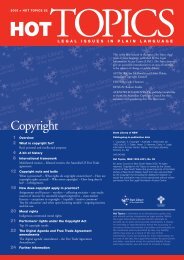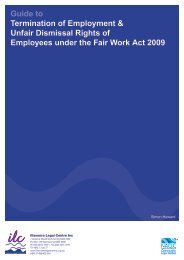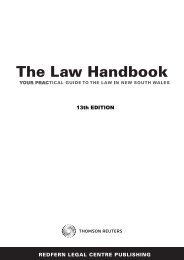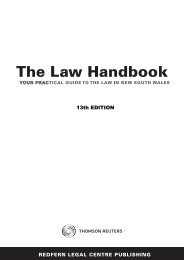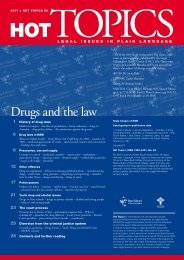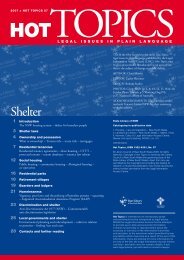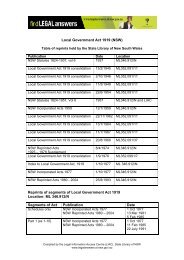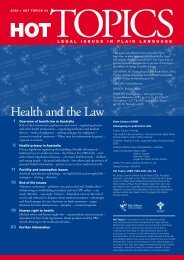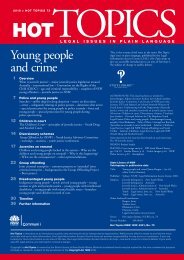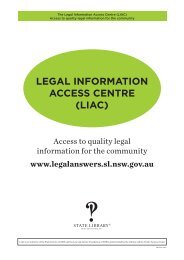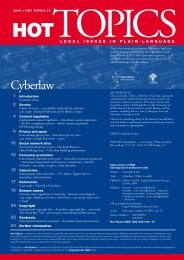Terrorism - Hot Topics 58 - Legal Information Access Centre
Terrorism - Hot Topics 58 - Legal Information Access Centre
Terrorism - Hot Topics 58 - Legal Information Access Centre
- No tags were found...
You also want an ePaper? Increase the reach of your titles
YUMPU automatically turns print PDFs into web optimized ePapers that Google loves.
1998. Similarly, apartheid South Africa sometimes usedmilitary force against incursions by African NationalCongress (ANC) freedom fighters based in neighbouringcountries. In some of these cases, the States claiming touse force in self-defence attacked the States harbouringterrorists and not only the terrorists themselves. Theseclaims to use military force against terrorists have beencontroversial, and many States traditionally rejectedthem.international law requirementsSince the UN Charter in 1945 outlawed the aggressiveuse of military force by States (see article 2(4) of the UNCharter), there have only been two situations in which itis lawful to use force:> in individual or collective self-defence if an ‘armedattack’ occurs (article 51 of the UN Charter); or> where the Security Council has authorised States touse force (Chapter VII of the Charter).An ‘armed attack’ is not defined, but includes aggressiveinvasion and other military violence on a substantialscale (for instance, more serious than sporadic borderclashes). Collective self-defence simply means that a Statewhich has been aggressively attacked may request otherStates to assist it in defending its territory against theaggressor. The Security Council may authorise force ifit identifies a threat to international peace and securitywhich requires a military response.The use of force in self-defence against terrorism wasproblematic because in many cases, once a terroristattack has occurred, there is no continuing attack whichrequires a defensive response. International law requiresthat self-defence must be necessary to repel an attack. Incontrast, using force after a terrorist attack has concludedmay be an unlawful reprisal – that is, an attempt topunish the attackers or to deter future attacks, but whichis not necessary to repel an ongoing attack. In addition,using force in self-defence must be a proportionateresponse to the original attack, and some militaryresponses to terrorism were excessive or disproportionatecompared with the initial attack. Other uses of forcewere intended to prevent future attacks – in other words,they were pre-emptive or anticipatory uses of force.The problem is that the UN Charter requires that an‘armed attack’ must have occurred, or be imminentlythreatening, before force can be used in self-defence.The use of force in self-defence against terrorism wasalso problematic because it had always been thoughtthat an ‘armed attack’ can only be committed by Statearmed forces, or by private militant groups controlled byStates. In the General Assembly’s 1974 Declaration on theDefinition of Aggression, approved by the InternationalCourt of Justice in the Nicaragua case 8 (1986), it wasobserved that the use of force by private individuals orgroups only constitutes an armed attack where there wasthe ‘sending by or on behalf of a state of armed bands,groups, irregulars or mercenaries, which carry out actsof armed force against another State of such gravity asto amount to acts of aggression.’ Some States used forceagainst terrorist attacks where the terrorists involvedwere not sent or controlled by any State, suggestingthat their use of force was not defensive but intendedto punish other States for not controlling terroristsoperating within their territories.use of force by the usImmediately after 11 September 2001, most countries, aswell as the Organisation of American States, the NorthAtlantic Treaty Organisation (NATO), the EuropeanUnion and various UN bodies, recognised that the UShad a right to use military force in self-defence againstthose attacks. By October 2001, the US, assisted by itsallies, launched a defensive military campaign, OperationEnduring Freedom, to attack Al-Qaeda and its Talibansupporters in Afghanistan. The scale of the 9/11 attackswas clearly considered serious enough by most States toamount to an armed attack triggering the right to selfdefence.The difficulty was whether any State was responsible forsending or controlling the Al-Qaeda attacks. On oneview, the Taliban regime, which was the de facto (that is,the effective but not legally recognised) government inmost of Afghanistan, exercised sufficient control over Al-Qaeda to make the 9/11 attacks attributable to the Stateof Afghanistan. This view is, however, doubtful. It seemsmore likely, on the available evidence, that the Talibanallowed Al-Qaeda to be based in Afghan territory, but theTaliban did not control or direct Al-Qaeda’s operations,including its attack on the US. In these circumstances,the traditional law of self-defence would not permit theUnited States to attack Afghanistan.The fact that most countries appeared to accept thatthe US could use force in self-defence after 9/11 maysuggest that States have accepted a modification of thetraditional law of self-defence. After 9/11, US PresidentBush asserted that the US would no longer distinguishbetween terrorists and those who ‘harboured’ them, evenif harbouring States did not actually control or directthe terrorists in their territory. In other words, the USclaimed that self-defence could be used against Statesfor simply failing to control terrorist groups in theirterritory. This new view of the law on self-defence maysimply be an isolated, exceptional case, limited to thecircumstances of 9/11, and which may not otherwiseeffect or change the existing law.In addition, even if the law has changed, any use offorce in self-defence must still be both necessary andproportionate. It is questionable whether overthrowingthe whole government of Afghanistan was a proportionate8. Military and Paramilitary Activities in and against Nicaragua (Nicaragua v United States), 1984 ICJ REP. 392 June 27, 1986, available athttp://www.icj-cij.org/icjwww/icases/inus/inusframe.htmterrorism and international Law 9



